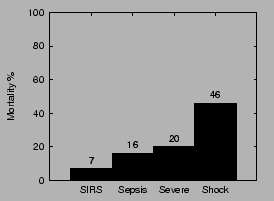 |

The five cardinal signs of inflammation taught in pathology are calor, rubor, dolor, tumor and function lasso or heat, redness, swelling and loss of function. It is prudent to remember that inflammation is the bodies response to many different situations. The young physician often confuses inflammation with infection and may wonder why his antibiotics have no effect in superficial thrombo-phlebitis, or similarly scratch her chin when they lack effect in the acute red foot of gout.
The systemic inflammtory response syndrome (SIRS) is a relatively new concept in surgery. It comes from work on sepsis, adult respiratory distress syndrome (ARDS) and multi organ dysfunction syndrome (MOF). Several different stimuli including, trauma (surgery), lipopolysaccharide and ischaemia-reperfusion (trauma, or vascular surgery) will result in an inflammatory response. This response or these responses are aimed at being beneficial but when exaggerated are actually lethal.
The importance of SIRS and MOF is that they are the leading cause of death in the patient in the surgical intensive therapy unit. A patient who survives a nasty trauma, burns or complicated extensive surgery may subsequently succumb to MOF. If the prognosis for these patients is to be improved then SIRS must be understood and novel therapies developed.
 Rangel-Frausto et al, have nicely demonstrated a stepwise progression in
mortality in patients based upon the severity of surgical sepsis
[RFPC+95].
Rangel-Frausto et al, have nicely demonstrated a stepwise progression in
mortality in patients based upon the severity of surgical sepsis
[RFPC+95].
